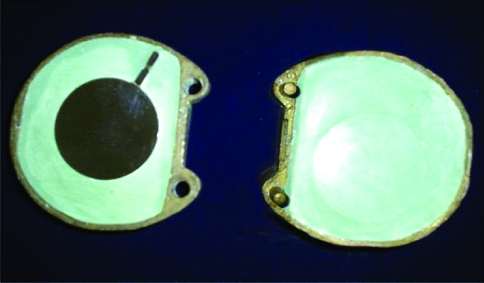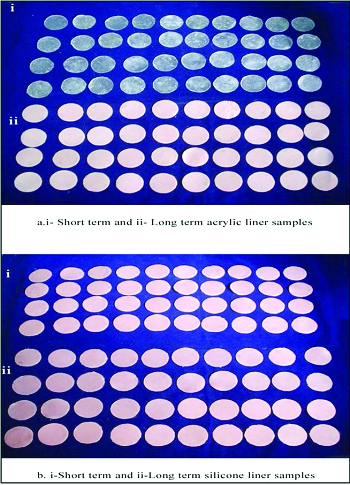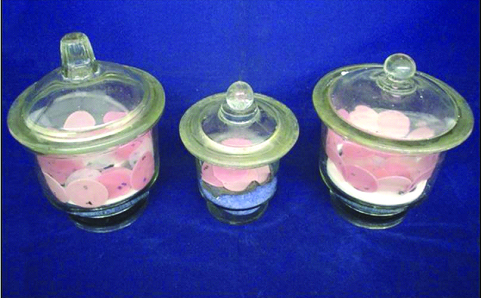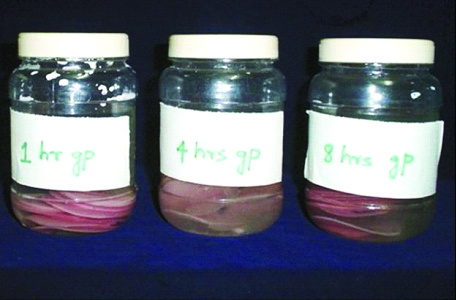Soft denture liners are indispensable in modern removable prosthodontics because of their key role in restoring health to inflamed and distorted denture supporting tissues [1]. They act as cushion for denture bearing mucosa through absorption and redistribution of forces transmitted to edentulous ridges [2]. Some of the desired properties of these soft liners are high bond strength to denture base, dimensional stability, resilience, low water sorption and solubility, good colour stability, relative ease of processing and biocompatibility. During usage, the rheological properties of these liners deteriorate and also, they are subjected to colonization by candida albicans. Therefore, effective plaque control is necessary for clinical use of these materials [3,4]. Although chemical cleansers are considered efficacious to prevent microbial colonization, daily use can affect the physical properties of the liners. Two common problems are water sorption and solubility associated with changes in the structure and properties of the soft liners [2].
Hence, the aim of the study was to evaluate the effect of different exposure times of a commonly used denture cleanser on sorption and solubility of four soft liners.
Materials and Methods
The present in vitro study was conducted in Krishna Dental College, Ghaziabad in December 2008. Procedure for sorption and solubility testing was done according to American Dental Association (ADA) specification No.12 [5]. A standard stainless steel metal disc was used to prepare test and control samples. Dimensions of the disc were as per ADA 12. Artificial saliva was prepared according to a previous study [6]. The denture cleanser solution was prepared according to manufacturer’s recommendation with 5mg of Clinsodent powder in 300 ml water; composition – Sodium perborate + Sodium lauryl sulphate; pH- 11. Metal discs were invested in dental flasks to prepare mould space for soft liner samples [Table/Fig-1]. All the samples were processed according to the manufacturer’s recommendations. Four material groups were used, long term and short term acrylic liners (Group A and Group B) and long term and short term silicone liners (Group C and group D). A total of 160 specimens were prepared, 40 for each group [Table/Fig-2]. All samples were desiccated for 24 hours using silica crystals [Table/Fig-3] to get a stable or conditioned weight W1. Each group was then further divided into four groups (10 control specimens + 30 test specimens): First control group- (10 specimens each for Groups A1, B1, C1, D1) liner samples were immersed in artificial saliva in a thermostatically controlled water bath at 370+10C for 7 days continuously. Second group (10 test specimens each for Groups A2, B2, C2, D2) - liners were immersed daily in cleanser for 1 hour and then transferred to artificial saliva for rest 23 hours of the day. Similarly samples of third (10 test specimens each for A3, B3, C3, D3) and fourth (10 specimens each for A4, B4, C4, D4) groups were immersed in cleanser for 4 and 8 hours respectively and transferred to artificial saliva for the rest 20 hours and 16 hours of the day respectively [Table/Fig-4]. Solutions of artificial saliva and denture cleanser were changed daily for the entire period of study, that is 7 days. Later, all control and test samples were removed from saliva, wiped dry, weighed for saturated weight W2. They were desiccated again for 24 hrs and weighed for reconditioned weight W3. An electronic weighing machine with an accuracy up-to three decimal points was used to weigh the samples.
Metal disk in mould space



Samples in denture cleanser

Sorption and solubility formula given by ADA specification-12
Formula for Sorption- W2-W1 (mg) / surface area of disc
Formula for Solubility- W1-W3 (mg) / surface area of disc
Surface area of disc – 2 πr (h +r) = 2 x 3.14 x 2.5 (0.1 + 2.5) – 40.82 cm2
Statistical Analysis
Descriptive (mean+SD) and comparative statistics were used for analysis. One-way ANOVA followed by Post-hoc Tukey’s test were used for pair wise comparisons. Significance was set at the probability level of p < 0.05.
Results
The mean results were interpreted both in tabular format. As indicated in [Table/Fig-5], both the sorption and solubility values for the long term acrylic increased with duration of immersion in cleanser, but only the solubility value of 8 hour cleanser immersion was significant compared to control.
Mean sorption and solubility of long term acrylic liner (mg/cm2).
| Sorption | Solubility |
|---|
| Mean | SD | % increase | Mean | SD | % increase |
|---|
| A1: Control | 0.4358 | 0.2816 | - | 0.8143a | 0.3129 | - |
| A2: 1 hr | 0.5029 | 0.4508 | 15% | 1.3508 | 0.3798 | 66% |
| A3: 4 hrs | 0.5997 | 0.7544 | 38% | 1.3915 | 0.3452 | 71% |
| A4: 8 hrs | 0.6237 | 0.4286 | 43% | 1.4395a | 0.1688 | 77% |
| ANOVA, F | 0.29p = 0.83, Not significantTukey’s interval = 0.87 | 8.75p<0.001, HSTukey’s interval = 0.68 |
Similar alphabets indicate significance between groups.
In case of short term acrylic [Table/Fig-6] mean sorption of 8hour group was statistically significant compared to control and 1 hour group. Solubility values of all test groups were insignificant. Though not significant, 1 hour sorption and 1 hour and 4 hour solubility were lower than those of control. This was the only liner that showed a variable trend of behaviour in contrast to other groups.
Mean sorption and solubility of short term acrylic liner (mg/cm2).
| Sorption | Solubility |
|---|
| Mean | SD | % change | Mean | SD | % change |
|---|
| B1 : Control | 0.4441a | 0.1727 | - | 1.6492 | 0.1002 | - |
| B2: 1 hr | 0.3778b | 0.3257 | (-) 15% | 1.3030 | 0.1809 | - 21% |
| B3: 4 hrs | 0.4642 | 0.1461 | (+) 5% | 1.3907 | 0.2440 | - 16% |
| B4: 8 hrs | 1.1575ab | 0.5955 | 62% | 1.6210 | 0.1002 | 2% |
| ANOVA, F | 10.48p < 0.001, HSTukey’s interval = 0.61 | 1.65p = 0.19, Not significantTukey’s interval = 0.72 |
Similar alphabets indicate significance between groups.
The 8 hour group of long term silicone liner showed significantly high sorption and solubility compared to control [Table/Fig-7]. Similarly, 8 hour sorption of short term silicone was significantly higher than control, however, both 4 hour and 8 hour solubility values were statistically significant to control [Table/Fig-8]. When all 4 materials were compared with each other, the following were observed:
Mean sorption and solubility of long term silicone liner (mg/cm2).
| Sorption | Solubility |
|---|
| Mean | SD | % increase | Mean | SD | % increase |
|---|
| C1: Control | 0.1850a | 0.0476 | - | 0.3221a | 0.1432 | - |
| C2: 1 hr | 0.3920 | 0.1790 | 112% | 0.4931 | 0.2071 | 53% |
| C3: 4 hrs | 0.4089 | 0.2045 | 121% | 0.5488 | 0.0877 | 70% |
| C4: 8 hrs | 0.7197a | 0.3570 | 289% | 0.5679a | 0.1375 | 76% |
| ANOVA, F | 9.55p< 0.001, HSTukey’s interval = 0.38 | 5.56p<0.001, HSTukey’s interval = 0.24 |
Similar alphabets indicate significance between groups.
Mean sorption and solubility of short term silicone liner (mg/cm2).
| Sorption | Solubility |
|---|
| Mean | SD | % increase | Mean | SD | % increase |
|---|
| D1: Control | 0.4512a | 0.2533 | - | 0.4559ab | 0.0939 | - |
| D2: 1 hr | 0.6350 | 0.3599 | 41% | 0.5590 | 0.1121 | 23% |
| D3: 4 hrs | 0.6575 | 0.3381 | 45% | 0.7092a | 0.1710 | 54% |
| D4: 8 hrs | 0.9929a | 0.3891 | 120% | 0.7014b | 0.2011 | 55% |
| ANOVA, F | 4.43p<0.01, SignificantTukey’s interval = 0.54 | 6.51p<0.001, HSTukey’s interval = 0.24 |
Similar alphabets indicate significance between groups.
Mean sorption values- In contrast to the other groups, the short term acrylic exhibited variable trend of behaviour. The 8 hour cleanser group showed the highest sorption. Long term silicone performed better than others except for its 8hour cleanser group. The 8 hour sorption of both the silicones was significantly higher than their control as compared to similar long term acrylic liner values.
Mean solubility values- The short term acrylic exhibited overall highest values as compared to the other groups. Both the silicone materials showed lower values of solubility compared to the acrylic liners with long term silicone showing the least solubility in artificial saliva and in cleanser.
Discussion
The international organization for standardization categorizes soft liners as short term liners (maximum usage 30 days) and long term liners (usage > 30 days, one year/longer) [7]. Sorption is a combination of adsorption and absorption.
According to the revised ADA specification 12 for denture base polymers [5] Sorption: Increase in weight of polymer shall not be more than 0.8 mg/cm2 of surface area after immersion in distilled water for seven days at 37+1°C. Solubility: Loss of weight of polymer shall not be more than 0.04 mg/cm2 of surface when tested according to the specification.
According to ADA 17 for tissue conditioners [3] - Water solubility and sorption shall be less than 0.07 mg/cm2 and 0.7 mg/cm2 respectively when stored for 24 hours at 37°C.
Kazanji MNM and Watkinson AC demonstrated percentage solubility of liners in artificial saliva was significantly higher than in distilled water [8]. However, percentage sorption of artificial saliva was significantly lower than in distilled water. The weight loss was related to the greater solubility of plasticisers in more ionic solutions than in water. The lower uptake or sorption in artificial saliva was explained in terms of ionic impurities. Contact angle and wettability of saliva also affect the sorption. This wettability of saliva is required as an adequate lubricating layer formed over the surface of liners [9]. This differing behaviour in artificial saliva should be considered when testing materials, since the results for artificial saliva are more likely to be clinically significant than those for distilled water.
Objectives of this study were to evaluate effect of different exposure times (time dependent effect) of a commonly used denture cleanser on sorption and solubility of four soft liners. It was attempted to conduct the study under simulated mouth conditions by using artificial saliva at 37°C+1oC.
Overall the silicone liners performed better than the acrylic liners. This result is in confirmation with the study by Nikawa et al., [10]. The long term silicone liner was most stable in terms of its sorption and solubility values and the short term acrylic was most unstable with high values of sorption and solubility. The reasons for the better behaviour of silicones over acrylics could be because of their better polymerization, cross-linking, low plasticiser content and more filler content. Hashem MI mentioned in his update on advances in soft denture liners, that the heat polymerised silicones had better bonding to filler and greater cross-linking leading to fewer micro-pockets for water [11]. Brozek R and others and Pahuja RK and co-workers studied the effects of denture cleansers on the behaviour and properties of different soft lining materials and found that the silicone liners performed better than the acrylic liners [12,13].
Analysis of long term data on water sorption by acrylic liners is complicated by gradual loss of plasticiser. Plasticisers decrease the amount of water uptake. This is attributed to hydrophobic nature of the plasticisers and ability to fill micro-voids in the resin [14]. Rate at which these materials absorbed water or lost soluble components varied with the type of material, amount of plasticisers and the solution of immersion. In this study, the long term acrylic liner demonstrated lower 8 hour sorption compared to that of silicones. However, the acrylic liners showed increased solubility owing to leaching out of the components. The composition of liner, the gelation process, pH of cleanser and time duration of exposure of liners to cleanser, all influence the physical properties of these elastomers [4,15].
The 8 hour immersion of 3 liners (long term acrylic, both silicone liners) in the cleanser caused significantly higher solubility compared to control hence immersion in the denture cleanser should be done for a shorter period. In case of short term acrylic liner solubility was high but insignificant with respect to time. Therefore, the effect of saliva may be more significant than cleanser. As there are not many previous studies evaluating effect of denture cleansers based on hours of immersion, further studies are needed.
As stated by Garcia et al., higher ionic concentration of the denture cleanser solution compared to water led to a higher release of soluble components [6]. These findings are in agreement with that of Goll et al., [1]. Results of this study showed that 1 week solubility values of all groups were much above the ADA specifications [3,5]. Solubility is expected to be more in more ionic solutions than in distilled water. The 1 week sorption and solubility values in previous studies [8,16] were also found to be higher than the quoted ADA specifications. Mansoor NS conducted a study on the effect of denture cleansers on sorption and solubility of soft denture lining materials immersed in different time intervals, where he used distilled water, an alkaline denture cleanser and citric acid cleanser [17]. He concluded that the general deterioration of the liner material increased with time of exposure to the cleansers.
The standard values given by the specifications in distilled water cannot be applied to these elastomeric materials which are continuously bathed in saliva, as the ionic nature of saliva increases the solubility. Hence, more studies are needed to standardise a specification for these liners in more ionic solutions.
Limitation
In this study, artificial saliva was prepared and used to simulate the natural saliva. However, it did not include the dynamic and diurnal variations of natural saliva that include presence of food, micro-organisms and other foreign bodies and changes in the pH caused by these as well as other physiological reasons in the individualised oral environment. This is the limitation of the study.
Conclusion
Within the limits of this study, the following were concluded;
Solubility values of all groups were higher than the quoted ADA specifications.
Overall, silicones performed better than acrylics. Long term silicone was most stable. Short term acrylic was most unstable.
The 8 hour cleanser immersion resulted in significantly high sorption and solubility. Hence, study suggests immersion in denture cleanser for a shorter period.
The processes of sorption and solubility are continuous and materials undergo changes in their physical properties and deteriorate over time. Thus, selection of a denture cleanser and the time duration for cleansing should be carefully established to minimize changes in the properties of resilient materials.
Similar alphabets indicate significance between groups.Similar alphabets indicate significance between groups.Similar alphabets indicate significance between groups.Similar alphabets indicate significance between groups.